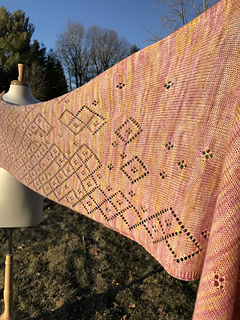patterns >  Kokoro Patterns
Kokoro Patterns
> Waiting for Spring





Waiting for Spring
The term hibernating, with its roots in the Latin word for winter, means to go dormant during periods of cold and to return to life with warmer weather. Although humans don’t technically hibernate, many of us find ourselves more sluggish and snuggly in the winter.
As knitters, we can go a step further: the cold brings an extra layer of delight to our craft, giving us a reason to knit while we wait for spring, and we can simultaneously push back the chill with our woolly works.
Our Waiting for Spring is a generously sized rectangular shawl meant to be knit while you wait for warmer weather. It also symbolizes the journey from winter to spring. The warm yellow and orange tones of the hand‐dyed colorway nod both to the citrus fruits of winter and the sunny days of summer. The lace motif is first regular and geometric, then slowly dissolves and blooms in a shower of eyelets; it shows the gradual shift from snow and ice crystals, to melt, to the first buds of spring, to a proliferation of blooms. Despondent Dye’s Ultra Merino yarn is more silky than bouncy, providing a perfect base for lace work as well as woolly comfort and protection from the cold. The resulting fabric is warm and snuggly, but it remains light enough to wear year round as a pure evocation of nature and the cycle of seasons.
Yarn and Yardage: Despondent Dye’s Ultra Merino Superwash 3-Ply, a 100% Ultra Merino yarn with soft luster and a brilliant hand. Two skeins in the Mimosa - Hold the Orange Juice colorway. Or, approximately 800-900 total yards of fingering or light fingering weight yarn.
Construction: Waiting for Spring is worked flat on the short edge.
Notions: Two stitch markers and a tapestry needle.
Techniques: Basic lace. The increases and decreases are worked only on the right side; wrong side rows are purled.
Instructions: The lace motifs are only charted.
As Modeled: The pictured shawl is the same in all four photos; two are taken in a warm morning light, and two in a cool evening light. We hope this shows how beautifully the yarn interacts with sunlight and transitions through the seasons.
214 projects
stashed
215 times
- First published: April 2018
- Page created: March 23, 2018
- Last updated: March 23, 2018 …
- visits in the last 24 hours
- visitors right now




